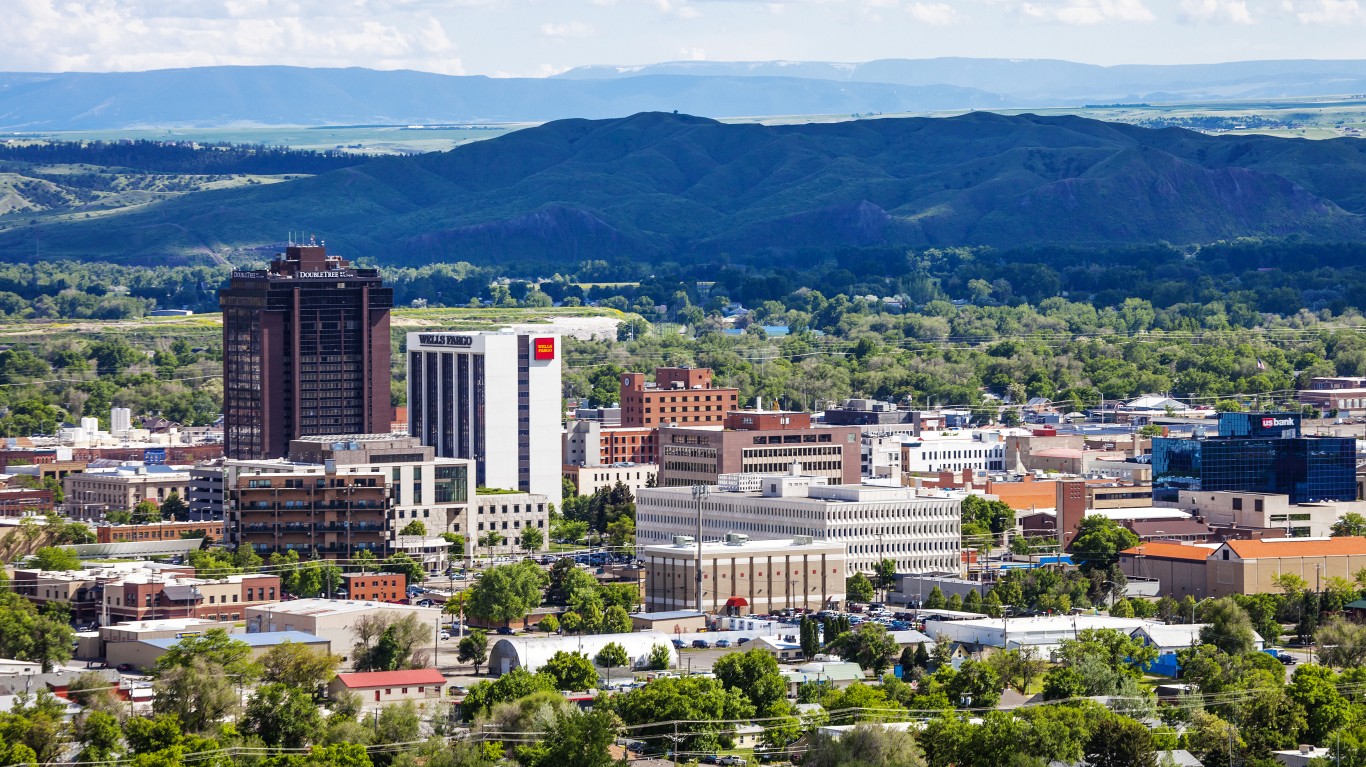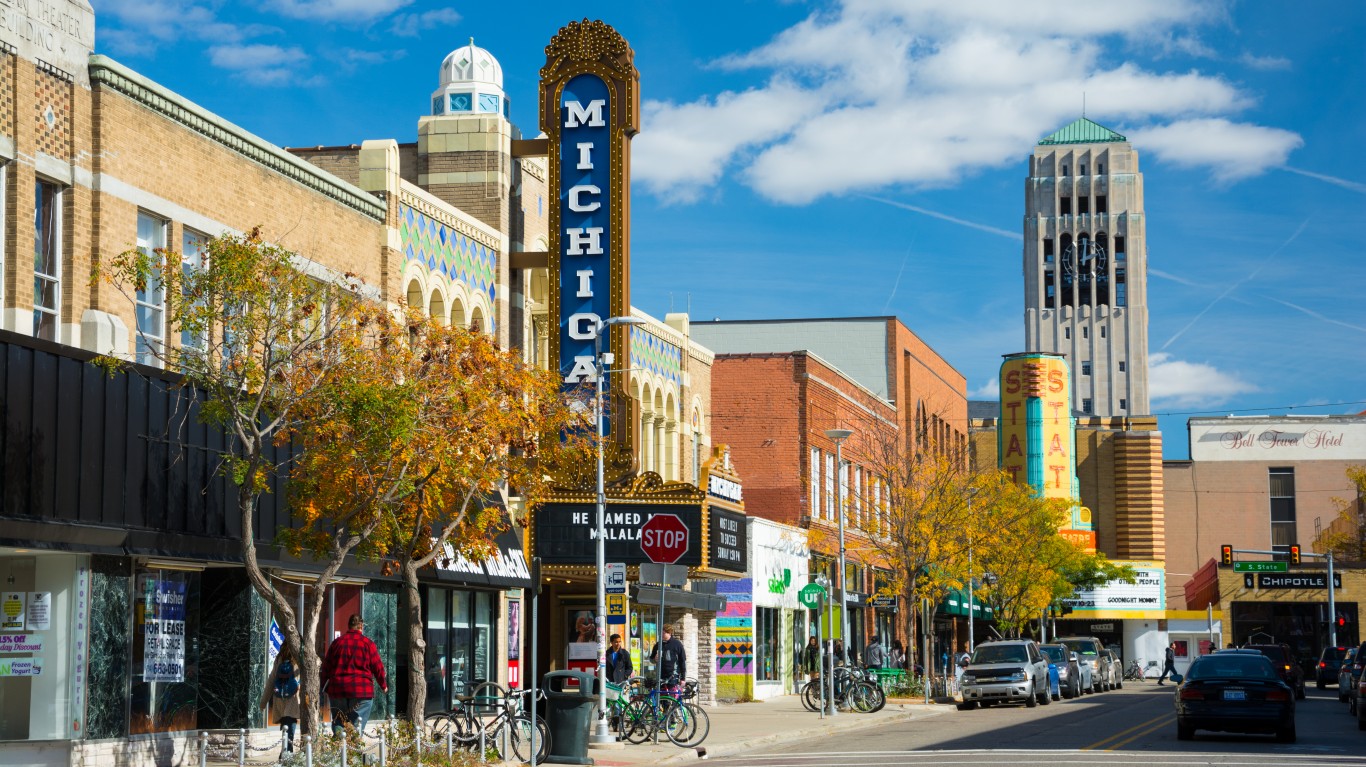Special Report
States Where Students Graduate With the Most Debt

Published:
Last Updated:

Vermont senator and presidential hopeful Bernie Sanders unveiled today a plan to eliminate all outstanding student loan debt in the United States. Student loan debt is a growing crisis, hitting an all time high of $1.5 trillion in 2019 and overtaking auto loans and credit card debt in the last decade. Today, more than 44 million Americans, or one in five adults, are saddled with student loan debt.
Though there are millions of Americans well into their 60s still paying off student loans, the problem is most pronounced among recent graduates. Some 58% of graduates from the class of 2017 are carrying debt, with debt averaging a staggering $28,288.
According to data from LendEDU, a financial product information website, student debt is not uniform across the country. In some states, recent graduates have nearly double the debt of recent graduates in other states. 24/7 Wall St. reviewed the average student debt among borrowers of the class of 2017 to identify the states where students graduate with the most debt.
Student debt burdens can have serious consequences, impacting both the borrower and society at large. Student debt has caused over a quarter of borrowers to wait to get married, over a third to wait to start a family, and over half to delay saving for retirement and buying a home, according to LendEDU.
As the crisis grows more urgent, proposals to address the issue are also becoming more common. Some high-profile lawmakers, including Sanders, have called for outright debt forgiveness, and the Treasury Department has recommended mandatory financial literacy courses for college students. Some of the states investing the most in higher education in the form of low-tuition public universities and loan programs are among the states with the lowest average debt.
While southern states struggle the most with credit card debt, student loan debt tends to be concentrated in the Northeast.
Click here to see the states where students graduate with the most student debt
Click here to read our methodology

50. Utah
> Avg. debt per borrower: $18,425
> Graduates with debt: 39% (the lowest)
> Adults with a bachelor’s degree: 34.6% (12th highest)
> Median household income: $68,358 (13th highest)
[in-text-ad]

49. New Mexico
> Avg. debt per borrower: $21,805
> Graduates with debt: 53% (14th lowest)
> Adults with a bachelor’s degree: 27.1% (11th lowest)
> Median household income: $46,744 (5th lowest)

48. Nevada
> Avg. debt per borrower: $22,026
> Graduates with debt: 49% (7th lowest)
> Adults with a bachelor’s degree: 24.9% (6th lowest)
> Median household income: $58,003 (25th lowest)

47. California
> Avg. debt per borrower: $22,383
> Graduates with debt: 50% (11th lowest)
> Adults with a bachelor’s degree: 33.6% (16th highest)
> Median household income: $71,805 (8th highest)
[in-text-ad-2]

46. Wyoming
> Avg. debt per borrower: $22,524
> Graduates with debt: 47% (3rd lowest)
> Adults with a bachelor’s degree: 27.6% (13th lowest)
> Median household income: $60,434 (19th highest)

45. Washington
> Avg. debt per borrower: $23,359
> Graduates with debt: 52% (13th lowest)
> Adults with a bachelor’s degree: 35.5% (11th highest)
> Median household income: $70,979 (10th highest)
[in-text-ad]

44. Florida
> Avg. debt per borrower: $23,556
> Graduates with debt: 50% (11th lowest)
> Adults with a bachelor’s degree: 29.7% (23rd lowest)
> Median household income: $52,594 (12th lowest)

43. Arizona
> Avg. debt per borrower: $23,913
> Graduates with debt: 54% (15th lowest)
> Adults with a bachelor’s degree: 29.4% (21st lowest)
> Median household income: $56,581 (23rd lowest)

42. Hawaii
> Avg. debt per borrower: $24,955
> Graduates with debt: 49% (7th lowest)
> Adults with a bachelor’s degree: 32.9% (18th highest)
> Median household income: $77,765 (3rd highest)
[in-text-ad-2]

41. Tennessee
> Avg. debt per borrower: $25,054
> Graduates with debt: 56% (21st lowest)
> Adults with a bachelor’s degree: 27.3% (12th lowest)
> Median household income: $51,340 (10th lowest)

40. Alaska
> Avg. debt per borrower: $25,349
> Graduates with debt: 46% (2nd lowest)
> Adults with a bachelor’s degree: 28.8% (17th lowest)
> Median household income: $73,181 (7th highest)
[in-text-ad]

39. Nebraska
> Avg. debt per borrower: $25,501
> Graduates with debt: 55% (18th lowest)
> Adults with a bachelor’s degree: 31.7% (21st highest)
> Median household income: $59,970 (21st highest)

38. North Dakota
> Avg. debt per borrower: $26,080
> Graduates with debt: 66% (6th highest)
> Adults with a bachelor’s degree: 30.7% (25th lowest)
> Median household income: $61,843 (18th highest)

37. North Carolina
> Avg. debt per borrower: $26,164
> Graduates with debt: 58% (22nd highest)
> Adults with a bachelor’s degree: 31.3% (24th highest)
> Median household income: $52,752 (13th lowest)
[in-text-ad-2]

36. Oklahoma
> Avg. debt per borrower: $26,270
> Graduates with debt: 48% (5th lowest)
> Adults with a bachelor’s degree: 25.5% (8th lowest)
> Median household income: $50,051 (8th lowest)

35. Arkansas
> Avg. debt per borrower: $26,561
> Graduates with debt: 55% (18th lowest)
> Adults with a bachelor’s degree: 23.4% (3rd lowest)
> Median household income: $45,869 (3rd lowest)
[in-text-ad]

34. Idaho
> Avg. debt per borrower: $26,604
> Graduates with debt: 61% (14th highest)
> Adults with a bachelor’s degree: 26.8% (10th lowest)
> Median household income: $52,225 (11th lowest)

33. Colorado
> Avg. debt per borrower: $26,662
> Graduates with debt: 52% (13th lowest)
> Adults with a bachelor’s degree: 41.2% (2nd highest)
> Median household income: $69,117 (11th highest)

32. Louisiana
> Avg. debt per borrower: $26,808
> Graduates with debt: 48% (5th lowest)
> Adults with a bachelor’s degree: 23.8% (4th lowest)
> Median household income: $46,145 (4th lowest)
[in-text-ad-2]

31. Missouri
> Avg. debt per borrower: $26,834
> Graduates with debt: 59% (18th highest)
> Adults with a bachelor’s degree: 29.1% (20th lowest)
> Median household income: $53,578 (15th lowest)

30. Texas
> Avg. debt per borrower: $27,001
> Graduates with debt: 55% (18th lowest)
> Adults with a bachelor’s degree: 29.6% (22nd lowest)
> Median household income: $59,206 (23rd highest)
[in-text-ad]

29. Oregon
> Avg. debt per borrower: $27,550
> Graduates with debt: 57% (23rd lowest)
> Adults with a bachelor’s degree: 33.7% (14th highest)
> Median household income: $60,212 (20th highest)

28. Kansas
> Avg. debt per borrower: $27,604
> Graduates with debt: 58% (22nd highest)
> Adults with a bachelor’s degree: 33.7% (14th highest)
> Median household income: $56,422 (21st lowest)

27. West Virginia
> Avg. debt per borrower: $27,608
> Graduates with debt: 70% (3rd highest)
> Adults with a bachelor’s degree: 20.2% (the lowest)
> Median household income: $43,469 (the lowest)
[in-text-ad-2]

26. Kentucky
> Avg. debt per borrower: $28,078
> Graduates with debt: 60% (16th highest)
> Adults with a bachelor’s degree: 24.0% (5th lowest)
> Median household income: $48,375 (7th lowest)

25. Georgia
> Avg. debt per borrower: $28,376
> Graduates with debt: 57% (23rd lowest)
> Adults with a bachelor’s degree: 30.9% (25th highest)
> Median household income: $56,183 (19th lowest)
[in-text-ad]

24. Montana
> Avg. debt per borrower: $28,389
> Graduates with debt: 59% (18th highest)
> Adults with a bachelor’s degree: 32.3% (19th highest)
> Median household income: $53,386 (14th lowest)

23. Illinois
> Avg. debt per borrower: $28,424
> Graduates with debt: 61% (14th highest)
> Adults with a bachelor’s degree: 34.4% (13th highest)
> Median household income: $62,992 (16th highest)

22. Maryland
> Avg. debt per borrower: $28,844
> Graduates with debt: 56% (21st lowest)
> Adults with a bachelor’s degree: 39.7% (3rd highest)
> Median household income: $80,776 (the highest)
[in-text-ad-2]

21. Virginia
> Avg. debt per borrower: $29,316
> Graduates with debt: 56% (21st lowest)
> Adults with a bachelor’s degree: 38.7% (5th highest)
> Median household income: $71,535 (9th highest)

20. Indiana
> Avg. debt per borrower: $29,405
> Graduates with debt: 58% (22nd highest)
> Adults with a bachelor’s degree: 26.8% (10th lowest)
> Median household income: $54,181 (17th lowest)
[in-text-ad]

19. Iowa
> Avg. debt per borrower: $29,411
> Graduates with debt: 62% (11th highest)
> Adults with a bachelor’s degree: 28.9% (18th lowest)
> Median household income: $58,570 (25th highest)

18. Wisconsin
> Avg. debt per borrower: $29,569
> Graduates with debt: 65% (7th highest)
> Adults with a bachelor’s degree: 30.4% (24th lowest)
> Median household income: $59,305 (22nd highest)

17. Vermont
> Avg. debt per borrower: $29,656
> Graduates with debt: 60% (16th highest)
> Adults with a bachelor’s degree: 38.3% (7th highest)
> Median household income: $57,513 (24th lowest)
[in-text-ad-2]

16. Ohio
> Avg. debt per borrower: $29,723
> Graduates with debt: 64% (8th highest)
> Adults with a bachelor’s degree: 28.0% (15th lowest)
> Median household income: $54,021 (16th lowest)

15. Mississippi
> Avg. debt per borrower: $30,268
> Graduates with debt: 50% (11th lowest)
> Adults with a bachelor’s degree: 21.9% (2nd lowest)
> Median household income: $43,529 (2nd lowest)
[in-text-ad]

14. South Carolina
> Avg. debt per borrower: $30,310
> Graduates with debt: 58% (22nd highest)
> Adults with a bachelor’s degree: 28.0% (15th lowest)
> Median household income: $50,570 (9th lowest)

13. Maine
> Avg. debt per borrower: $30,321
> Graduates with debt: 59% (18th highest)
> Adults with a bachelor’s degree: 32.1% (20th highest)
> Median household income: $56,277 (20th lowest)

12. New Jersey
> Avg. debt per borrower: $30,794
> Graduates with debt: 62% (11th highest)
> Adults with a bachelor’s degree: 39.7% (3rd highest)
> Median household income: $80,088 (2nd highest)
[in-text-ad-2]

11. Michigan
> Avg. debt per borrower: $30,978
> Graduates with debt: 58% (22nd highest)
> Adults with a bachelor’s degree: 29.1% (20th lowest)
> Median household income: $54,909 (18th lowest)

10. Minnesota
> Avg. debt per borrower: $31,231
> Graduates with debt: 68% (4th highest)
> Adults with a bachelor’s degree: 36.1% (9th highest)
> Median household income: $68,388 (12th highest)
[in-text-ad]

9. Massachusetts
> Avg. debt per borrower: $31,319
> Graduates with debt: 59% (18th highest)
> Adults with a bachelor’s degree: 43.4% (the highest)
> Median household income: $77,385 (4th highest)

8. South Dakota
> Avg. debt per borrower: $31,332
> Graduates with debt: 73% (2nd highest)
> Adults with a bachelor’s degree: 28.1% (16th lowest)
> Median household income: $56,521 (22nd lowest)

7. New York
> Avg. debt per borrower: $31,506
> Graduates with debt: 64% (8th highest)
> Adults with a bachelor’s degree: 36.0% (10th highest)
> Median household income: $64,894 (14th highest)
[in-text-ad-2]

6. Connecticut
> Avg. debt per borrower: $31,643
> Graduates with debt: 58% (22nd highest)
> Adults with a bachelor’s degree: 38.7% (5th highest)
> Median household income: $74,168 (5th highest)

5. Alabama
> Avg. debt per borrower: $31,861
> Graduates with debt: 50% (11th lowest)
> Adults with a bachelor’s degree: 25.5% (8th lowest)
> Median household income: $48,123 (6th lowest)
[in-text-ad]

4. New Hampshire
> Avg. debt per borrower: $33,462
> Graduates with debt: 74% (the highest)
> Adults with a bachelor’s degree: 36.9% (8th highest)
> Median household income: $73,381 (6th highest)

3. Delaware
> Avg. debt per borrower: $34,144
> Graduates with debt: 62% (11th highest)
> Adults with a bachelor’s degree: 31.5% (22nd highest)
> Median household income: $62,852 (17th highest)

2. Rhode Island
> Avg. debt per borrower: $35,371
> Graduates with debt: 64% (8th highest)
> Adults with a bachelor’s degree: 33.5% (17th highest)
> Median household income: $63,870 (15th highest)
[in-text-ad-2]

1. Pennsylvania
> Avg. debt per borrower: $36,193
> Graduates with debt: 67% (5th highest)
> Adults with a bachelor’s degree: 31.4% (23rd highest)
> Median household income: $59,195 (24th highest)
Methodology
To identify the states with the most student debt, 24/7 Wall St. reviewed the average student debt per borrower by state in 2019, which was compiled by LendEDU. The percentage change from the class of 2016, as well as the portion of graduates with debt, is also from LendEDU. Bachelor’s degree attainment rate and the median household income for earners 25-44 is from the American Community Survey 1-Year Estimates for 2017.
The thought of burdening your family with a financial disaster is most Americans’ nightmare. However, recent studies show that over 100 million Americans still don’t have proper life insurance in the event they pass away.
Life insurance can bring peace of mind – ensuring your loved ones are safeguarded against unforeseen expenses and debts. With premiums often lower than expected and a variety of plans tailored to different life stages and health conditions, securing a policy is more accessible than ever.
A quick, no-obligation quote can provide valuable insight into what’s available and what might best suit your family’s needs. Life insurance is a simple step you can take today to help secure peace of mind for your loved ones tomorrow.
Click here to learn how to get a quote in just a few minutes.
Thank you for reading! Have some feedback for us?
Contact the 24/7 Wall St. editorial team.